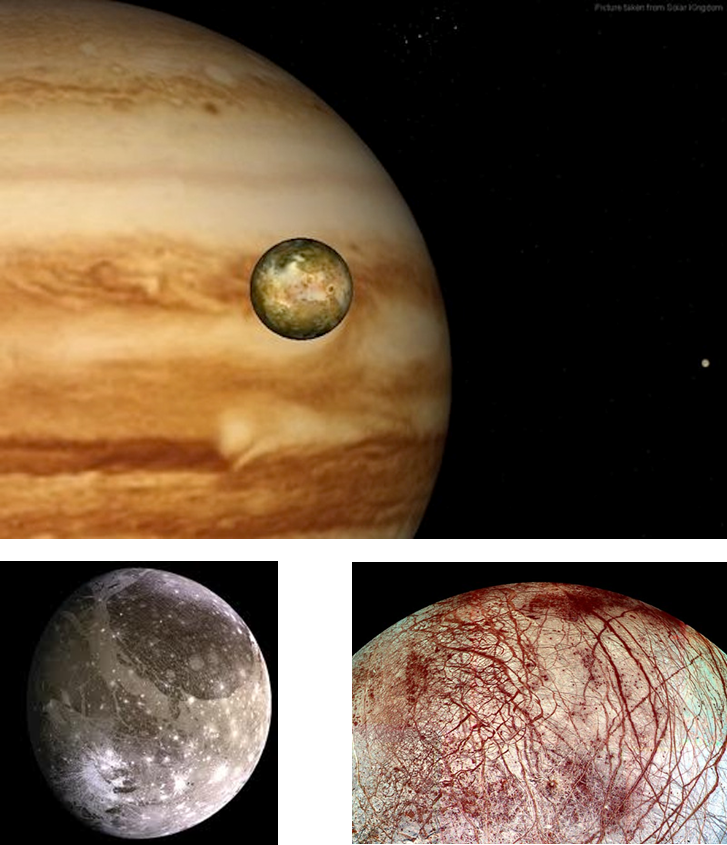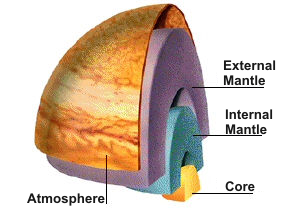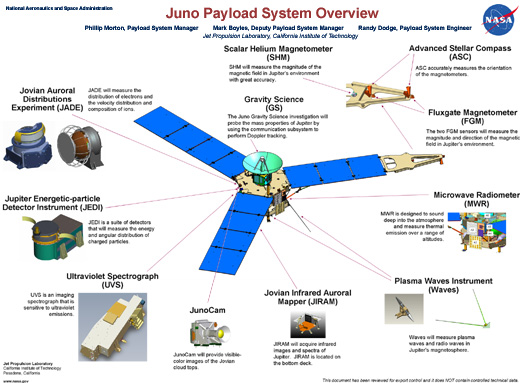The Grand Tour whet our appetite for learning more about planets and asteroids beyond our closest neighbour Mars. To once more explore Solar System bodies at extreme distances technology needed to be designed with its own intelligence to operate autonomously and reliably over long duration in the cold of interplanetary space. Remarkably the robotic spacecraft NASA designed to achieve these long duration flights has performed optimally.
With Jupiter our first destination, followed by Saturn, two members of the Asteroid Belt, and Pluto and Charon, these voyages straddled the end of the 20th and beginning of the 21st century. So let’s begin with our return to Jupiter on a spacecraft named Galileo and then discuss other missions in progress or planning and why we keep going back to this gas giant.
What compelled us to return to Jupiter after the successes of the Pioneer and Voyager missions? There were lots of unanswered questions about Jupiter, when it formed, where it formed whether it has a solid core and its structural composition, and which if any of its moons had liquid water and the ability to sustain life. We wanted to understand how one moon, Io, could be constantly going through the throws of reforming its crust with more active volcanoes than any other body in the Solar System including Venus.
Galileo – A Voyage of Discovery That Changed Our View of Jupiter and its Moons Forever
The Galileo mission was designed to address some of these questions. A spacecraft designed in the 1980s, it took nearly six years from its launch in 1989 to get to Jupiter. Its route took it first by Venus once and Earth twice before developing the gravity-assisted speed necessary to coast past Mars and through the Asteroid Belt to Jupiter.
While on route it rendezvoused with two asteroids, first Gaspra in 1991 and later Ida in 1993. While passing Ida it captured a picture of the asteroid and its accompanying moonlet named Dactyl. A year later on approach to Jupiter it bore first-hand witness to the destruction of Comet Shoemaker-Levy as it impacted the planet.
Galileo finally arrived at Jupiter in December 1995. It launched a companion atmospheric probe on July 13, 1995. The probe descended through 200 kilometers (124 miles) of the planet’s outer atmosphere collecting data on local weather conditions – for July 13, a dry day with a few clouds and distant lightning. As the probe descended further it experienced winds exceeding 720 kilometers (450 miles) per hour and finally vaporized in the intense heat of the atmosphere after 61 minutes of transmission.
Galileo’s path around Jupiter took it in long elongated orbits around the planet, each averaging about two months. The orbits allowed the spacecraft to sample Jupiter’s magnetosphere in different locations while performing close rendezvous with Jupiter’s many moons. After 35 of these orbits and almost eight years of operation in the planet’s vicinity Galileo was instructed to self-destruct in the Jovian atmosphere to avoid a potential contaminating impact with the moon Europa.
What answers did Galileo give us to the questions we had about Jupiter and the Jovian system?
- It answered the question about the moons in discovering evidence of a saltwater ocean under Europa’s icy crust and liquid bodies of saltwater on two other moons, Ganymede (the largest moon in the Solar System) and Callisto.
- It gave us a better understanding of the gravitational forces of Jupiter responsible for the active volcanic and tectonic processes witnessed on the moon, Io. Such forces were little understood until scientists took a close look at the lava lakes and molten rock flows of this Jovian moon where temperatures exceeded 1,700 degrees Celsius, hotter than any place in the Solar System other than the Sun.
- With its probe on onboard science instruments we got our first good picture of conditions within Jupiter’s atmosphere. We studied the stationary storm, Jupiter’s Great Red Spot, the planet’s auroras, its magnetosphere, and its tenuous dark rings.
- In the discovery of larger than anticipated concentrations of argon, krypton and xenon, noble gases, it raised more questions about when and where Jupiter originated.
- And it raised a whole bunch of new questions about Jupiter’s largest moon, Ganymede, a moon with its own magnetic field suggesting a dense liquid metal core similar to that found inside Earth. Even more surprising Galileo also discovered that Ganymede’s tenuous atmosphere contained O1 and O2 molecular oxygen as well as O3 (ozone).

Because of these discoveries and the many still unanswered and new questions that arose from Galileo’s mission, Jupiter is once again to be visited by a new spacecraft, Juno, that will focus on the planet exclusively. The Juno mission will be followed by a new robotic spacecraft, Juice, with a mission to study the Jovian system and in particular its ice moons.
Juno – Dissecting Jupiter to Understand How the Solar System Formed
Jupiter is the largest planet in the Solar System. Its mass is greater than all the other planets combined. Scientists theorize it was the first planet to form out of the nebula that condensed to form our proto-Sun and its planetary companions. What is not known is where Jupiter formed? The presence of large quantities of noble gases as found by Galileo suggests that Jupiter may have formed much further out than its present position as fifth planet from the Sun. Juno, the next mission to Jupiter may provide us with answers and help us learn more about the earliest period in the Solar System’s formation.
In returning to Jupiter with Juno the goal this time is to focus on the planet itself and not the larger Jovian system. Scientists hope to learn more about the origins of the Solar System by studying Jupiter, its composition, whether it has a solid core, and the mechanism behind its powerful magnetic field.

Juno is a very different spacecraft than Galileo. It is solar powered. Galileo was powered by a Radioisotope Thermal Generator (RTG). In choosing solar over RTG the spacecraft designers have built a significant solar array with three panels, each 2 meters (6 1/2 feet) wide and 9 meters (almost 30 feet) in length. The size of this array is significantly larger than any previous robotic spacecraft. Why? Because sunlight near Jupiter is 27 times weaker than sunlight near Earth.
In addition the spacecraft is designed to fly with its solar panels always sun facing to maximize its ability to power the instrumentation package on board (see image below).
Upon its arrival in 2016 Juno will enter a close polar orbit around the planet taken it within 100 kilometers of the cloud tops. In this way Juno will be less exposed to the Jovian magnetosphere while it directs its scientific instruments at studying the planet below. After 32 to 33 orbits taking approximately one year the plan is to deorbit the spacecraft to burn up in the atmosphere in October 2017.
Juice – Europe’s Contribution to Exploring the Jovian System
The Juno mission is not our last visit to the vicinity of Jupiter. Other missions are planned including a lander with technology to drill into the surface of Europa to sample its subsurface ocean, and a new mission from the European Space Agency (ESA), named Juice, planned for a launch in 2022 with arrival at Jupiter by 2030.
Juice stands for Jupiter Icy Moons Explorer. The mission will study Europa, Ganymede and Callisto. The spacecraft will make several flybys of these moons while doing further studies of Jupiter’s atmosphere and magnetosphere and how the latter interacts with its moons. The plan includes a final rendezvous with Ganymede with Juice entering into orbit around that moon in 2032.
In choosing Ganymede as its final destination Juice will study its atmosphere, icy surface, internal structure and subsurface ocean as well as its unique magnetosphere.
Our next stop in our exploration of the outer planets – Saturn.








